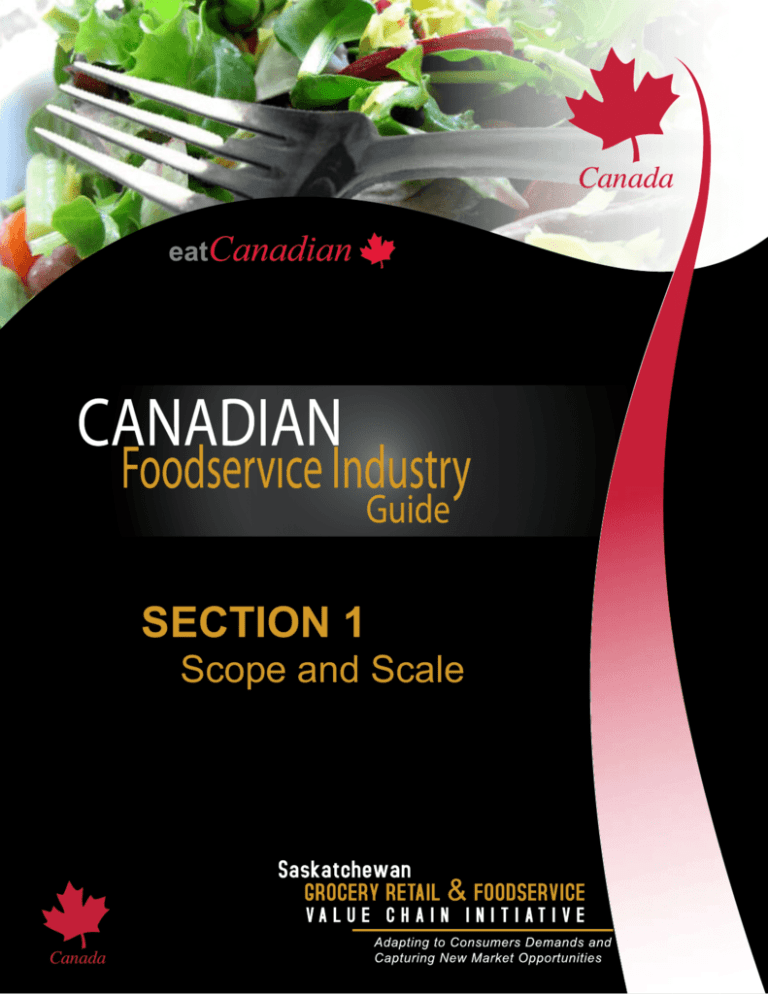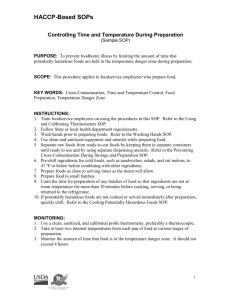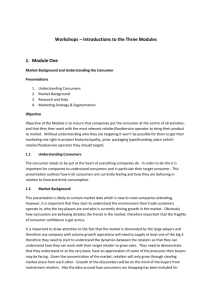
SECTION 1
Scope and Scale
1
Section 1
Scope and Scale
Together, FSR and LSR make up
approximately 69% of the commercial
foodservice industry in Canada.
Caterers: Caterers comprise two
separate and distinct groups: The first
is Contract Caterers – companies that
manage foodservices in institutions such
as attractions, educational facilities,
business and industry facilities, healthcare
establishments, correctional facilities,
remote camps and transportation facilities.
The second is Social Caterers – companies
that operate banquet halls, off-premise
catering services or mobile catering
vehicles.
Canadian Foodservice Channels:
Descriptions
The Canadian Restaurant & Foodservices
Association (CRFA) divides the Canadian
Foodservice Industry (“the Industry”) into two
general segments: Commercial and NonCommercial, each with its own subcategories.
Commercial foodservice represents
approximately 79% of total industry sales and
includes:
Full Service Restaurants (FSR): FSRs
are restaurants where the customer’s order
is taken at and delivered to a table. Some
FSRs offer takeout and delivery service
but table service is the mainstay of their
business.
Limited Service Restaurants (LSR):
LSRs are restaurants where part or all of
the transaction takes place at a counter or
window. Modified counter service, where
the order is taken at a counter but delivered
to a table, is another example of an LSR.
LSRs are sometimes referred to as QSR or
Quick Service Restaurants.
Drinking Places: This includes pubs,
taverns and bars where the primary product
being offered is alcoholic beverages but
food is also served.
Non-Commercial foodservices are operations
whose primary business focus is not
foodservice; food may be offered as a service
or an amenity for the key stake holders of their
operation. These include:
Accommodation: This segment includes
cafés, restaurants, bars, room service and
catering within hotels and resorts.
Retail: This segment includes foodservice
operations in retail venues such as
department stores, convenience stores and
gas stations. This does not include branded
foodservice concepts such as Tim Horton’s
or Subway.
Institutional: This segment includes
all foodservice operations in institutions
(e.g., attractions, educational facilities,
business and industry facilities, healthcare
establishments, correctional facilities,
2
Section 1
remote camps and transportation facilities)
where the foodservices operations are
operated by the institution itself (as opposed
to a contract caterer).
Other: Any other foodservice operation that
is not classified as “Commercial”
2010 Forecasted Sales Share by Segment
Canadian Foodservice Sales
3
Section 1
Canadian Foodservice Industry sales
were approximately $58.1 billion in 2009;
representing roughly 4% of Canada’s GDP for
that year.
The CRFA forecasts industry sales of $60.1
billion for 2010; a 3.1% increase.
Significant years in this analysis are 1991
(recession and the introduction of GST) and
2009 (recession). Other than these years, the
foodservice industry has shown steady growth,
doubling size in 20 years.
All Foodservice: Sales forecast by industry segment
Nominal sales growth is defined as sales
growth including inflation as a result of price
increases.
Total foodservice sales are expected to
increase by 3.1% in 2010 compared to 2009.
Accommodation is expected to achieve the
highest nominal sales growth due to the
anticipation of recovery in hotel occupancy
rates after 20091. Conversely, drinking places
will likely see the lowest nominal growth.
It is interesting to note that all non-commercial
segments are expected to out perform the
industry average in nominal growth.
Source: PKF Consulting: http://www.pkfcanada.
com/trends_research/news_articles/2009/dec.html
1
4
Section 1
Commercial Foodservice: Top 50
Operators’ share of units and revenue
Historically, the top 50 commercial foodservice
operators in Canada represent approximately
one quarter to one third of industry units;
however, they represent half of commercial
foodservice sales. This illustrates the
significant difference chain restaurants have
in sales per restaurant over independent
restaurants.
5
Section 1
Commercial Foodservice: Chains vs.
Independents (Sales)
Chains (defined as brands operating three
or more outlets) represent over 60% of
commercial foodservice sales in all regions of
Canada except Quebec.
In Quebec, independent operators generate
50% of sales; nevertheless, chain operator
sales in Quebec are on the rise. It is only in
recent years that Quebec independent sales
have dropped to be equal or below that of
chain operations; this is a sign of the growing
significance of the chain restaurant model in
today’s industry.
6
Section 1
Commercial Foodservice: Operating
margins by operation classification
Compared to many industries, the foodservice
industry generates low net profits as a percent
of total revenue. According to the 2009 CRFA
Operations Report the average foodservice
operation saw a net profit of
only 4% of total revenue –
1.6% lower than in 2000.
Cost of Goods Sold (COGS),
the cost of purchases of foods
and beverages, represents
the largest operating expense
in all segments except for
contract and social catering.
Combined, COGS and labour
costs equal almost 70% of
revenue. The impact of these
variables continues to grow.
In 2000, COGS and labour
were approximately 64% of
sales.
Food growers and processors
wishing to sell to the foodservice
market must recognize the
challenge faced by operators in
this regard.
7
Section 1
Commercial Foodservice: Share of
Food Dollar – USA vs. Canada, % of
meals away from home
In 2009, Canadians spent 36.9% of their food
dollar on food away from home (purchased in
foodservice outlets as opposed to grocery retail
outlets); this is the lowest share of food dollar
since 1998.
Overall the Canadian foodservice share of
food dollar is declining. Conversely, food dollar
share in the United States, typically higher than
Canada’s to begin with, is gradually increasing,
reaching 49% in 2009.
[Interesting that US rose with poor economy,
while Canada dropped. In fact adding a linear
trend line shows Canada trending down while
US trends upward.]
Contract Caterers and Institutional
Foodservice: Market share
by segment
Healthcare accounts for over 45%
of the contract and institutional
foodservice markets in Canada
and remains primarily selfoperated.
Foodservices in remote camps,
education, and business dining are
most often operated by a contract
caterer. Military and correctional
foodservices are, for the most
part, operated by the institutions
themselves.
8
For additional information pertaining to the Foodservice Guide, please contact:
Bryan Kosteroski
Value Chain Specialist
Agriculture Council of Saskatchewan
104 - 411 Downey Road
Saskatoon Saskatchewan
Canada S7N 4L8
Office (306) 975-6851
Cellular (306) 229-8986
Email – kosteroskib@agcouncil.ca
Website – www.saskvaluechain.ca
The Agriculture Council of Saskatchewan (ACS) Inc. has developed this electronic guide for the Canadian
foodservice industry as part of its continuing efforts to support the agriculture and agri-food industry and
develop the capacity and tools for food growers and processors to enter the foodservice industry.
The purpose of the guide is to provide food growers and processors with a better understanding of the
foodservice industry and how to tap into business opportunities within it. To that end, ACS has engaged
fsSTRATEGY Inc., consultants to the foodservice industry, to help create this powerful reference tool.
fsSTRATEGY is an alliance of senior consultants focusing on business strategy support – research,
analysis, design and implementation – for the foodservice industry. Their team has extensive consulting
experience in foodservice across Canada.
Acknowledgements
Geoff Wilson, B.Comm., CFE, CMC, ISHC fsSTRATEGY Inc.
Andrew Waddington fsSTRATEGY Inc.
www.saskvaluechain.ca
DISCLAIMER
WHILE EVERY EFFORT HAS BEEN MADE TO ENSURE ACCURACY, NONE OF THE SPONSORING
AGENCIES OR AUTHORS ACCEPTS RESPONSIBILITY FOR ERRORS OR OMISSIONS. THE PUBLISHER,
EDITORS AND ALL CONTRIBUTORS TO THIS PUBLICATION CANNOT BE HELD RESPONSIBLE FOR
PUBLICATION ERRORS OR ANY CONSEQUENCES RESULTING FROM THE USE OF THIS PUBLICATION.
ALL RIGHTS RESERVED. NO PART OF THIS PUBLICATION MAY BE REPRODUCED, STORED IN A
RETRIEVAL SYSTEM, OR TRANSMITTED IN ANY FORM OR BY ANY MEANS, ELECTRONIC MECHANICAL
PHOTOCOPYING, RECORDING OR OTHERWISE, WITHOUT WRITTEN PERMISSION FROM THE
AGRICULTURE COUNCIL OF SASKATCHEWAN INC.
© Copyright 2010
Funding for this project has been provided by Agriculture and Agri-Food Canada through the
Canadian Agricultural Adaptation Program (CAAP). In Saskatchewan, this program is delivered by the
Agriculture Council of Saskatchewan.
10








